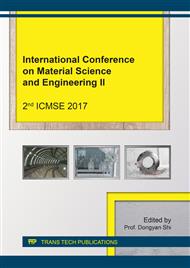p.52
p.57
p.64
p.71
p.76
p.84
p.91
p.97
p.105
Analysis of the Structures and Thermal Properties of Hexanediamine Adipate and Pentanediamine Adipate
Abstract:
Hexanediamine adipate, pentanediamine adipate and bio-based pentanediamine adipate were prepared by adipic acid reaction with 1,6-hexanediamine, 1,5-pentanediamine and bio-based 1,5-pentanediamine, respectively. Their structures and thermal properties have been analyzed by infrared spectra, SEM, DSC and TGA. Infrared spectra showed the main differences between 1,6-hexanediamine and 1,5-pentanediamine for the deformation vibration and out of plane bending vibration of N−H. Hexanediamine adipate and pentanediamine adipate had the difference at the asymmetric stretching vibration of −COO-−. The crystal morphologies of hexanediamine adipate and pentanediamine adipate showed dendritic and acicular, respectively. The melting point of pentanediamine adipate, pentanediamine adipate and bio-based pentanediamine adipate were 208.0 °C, 182.3 °C and 182.9 °C, respectively. The polymerization of hexanediamine adipate, pentanediamine adipate and bio-based pentanediamine adipate happened at 201.0, 190.2 and 194.9 °C, respectively. And the decomposition temperature of PA66, PA56 and bio-based PA56 were 401.8, 403.5 and 405.2 °C, respectively.
Info:
Periodical:
Pages:
76-83
Citation:
Online since:
February 2018
Authors:
Price:
Сopyright:
© 2018 Trans Tech Publications Ltd. All Rights Reserved
Share:
Citation:


